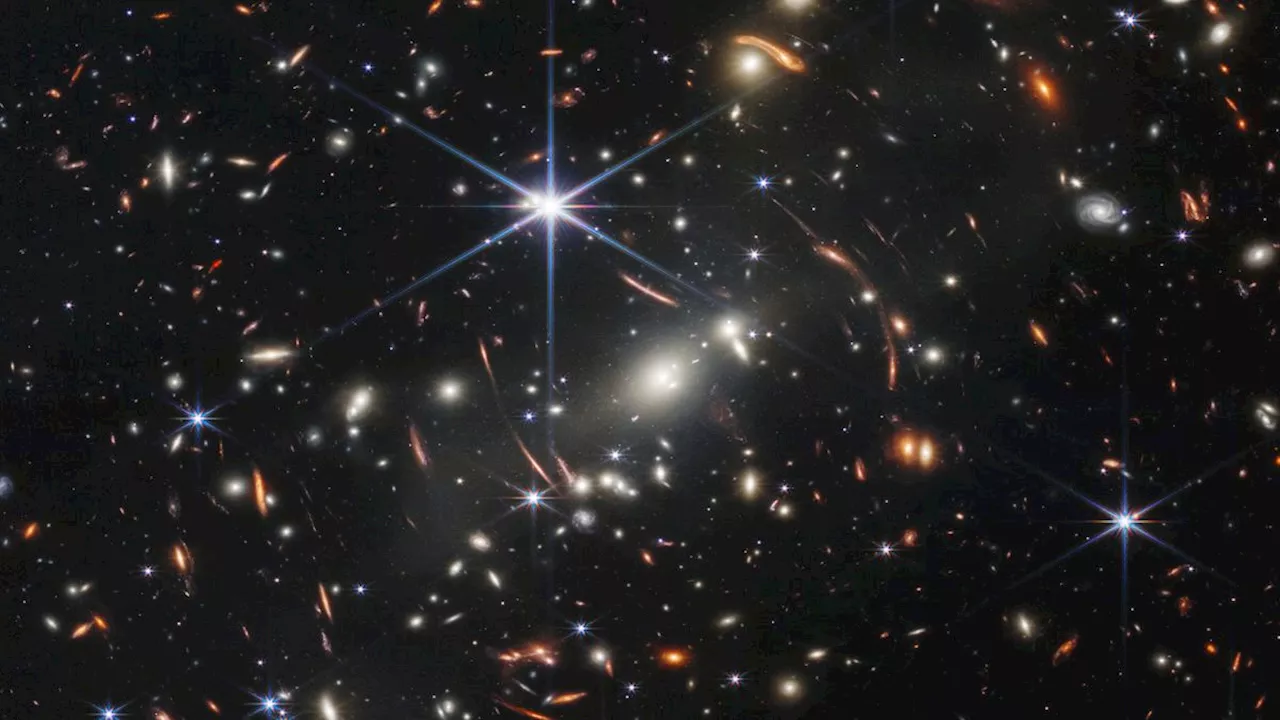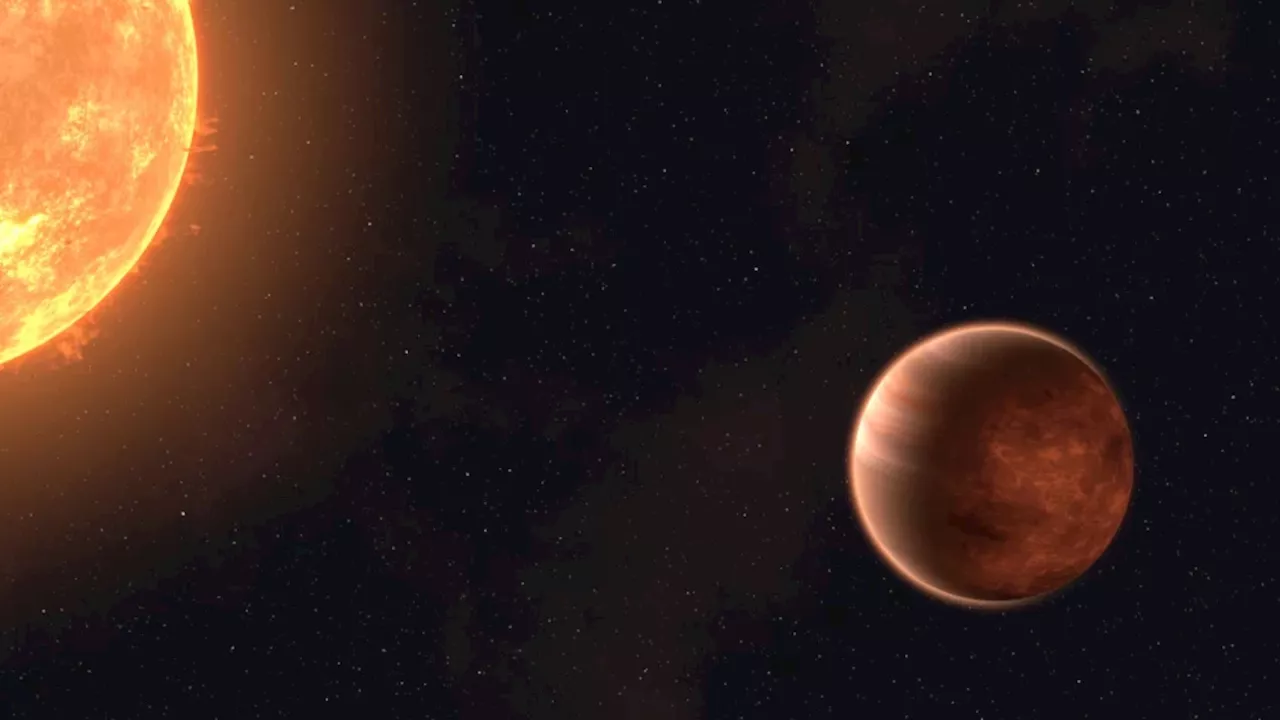Robert Lea is a science journalist in the U.K. whose articles have been published in Physics World, New Scientist, Astronomy Magazine, All About Space, Newsweek and ZME Science. He also writes about science communication for Elsevier and the European Journal of Physics. Rob holds a bachelor of science degree in physics and astronomy from the U.K.
This multiwavelength image of the Cloverleaf ORC combines visible light observations from the DESI Legacy Survey in white and yellow, X-rays from XMM-Newton in blue, and radio from ASKAP in red.XMM-Newton, a European Space Agency and NASA-operated space telescope, has imaged a vast cosmic"Cloverleaf" to uncover its mysterious origins.
The power needed to create such a structure is immense, leading astronomers to ponder about what events could be violentto create ORCs. Thanks to the observations XMM-Newton, researchers think the Cloverleaf's creation event was a collision between two groups of galaxies.
"That measurement let us deduce that the Cloverleaf ORC is hosted by around a dozen galaxies that have gravitated together, which agrees with what we see in deep visible light images," Zhang said.Artist's impression of an odd radio circle exploding from a central galaxy and expanding past other galaxies.
"Galaxies interact and coalesce all the time," Kim Weaver, the NASA project scientist for XMM-Newton at NASA's Goddard Space Flight Center who was not involved in the study, said in the statement."But the source of the accelerated particles is unclear." that sit at the heart of each of the colliding galaxies. These black holes may have gone through episodes of feeding and extreme activity in the past.
United Kingdom Latest News, United Kingdom Headlines
Similar News:You can also read news stories similar to this one that we have collected from other news sources.
 Does a cosmic 'glitch' in gravity challenge Albert Einstein's greatest theory?Robert Lea is a science journalist in the U.K. whose articles have been published in Physics World, New Scientist, Astronomy Magazine, All About Space, Newsweek and ZME Science. He also writes about science communication for Elsevier and the European Journal of Physics. Rob holds a bachelor of science degree in physics and astronomy from the U.K.
Does a cosmic 'glitch' in gravity challenge Albert Einstein's greatest theory?Robert Lea is a science journalist in the U.K. whose articles have been published in Physics World, New Scientist, Astronomy Magazine, All About Space, Newsweek and ZME Science. He also writes about science communication for Elsevier and the European Journal of Physics. Rob holds a bachelor of science degree in physics and astronomy from the U.K.
Read more »
 Did the James Webb Space Telescope really find life beyond Earth? Scientists aren't so sureRobert Lea is a science journalist in the U.K. whose articles have been published in Physics World, New Scientist, Astronomy Magazine, All About Space, Newsweek and ZME Science. He also writes about science communication for Elsevier and the European Journal of Physics. Rob holds a bachelor of science degree in physics and astronomy from the U.K.
Did the James Webb Space Telescope really find life beyond Earth? Scientists aren't so sureRobert Lea is a science journalist in the U.K. whose articles have been published in Physics World, New Scientist, Astronomy Magazine, All About Space, Newsweek and ZME Science. He also writes about science communication for Elsevier and the European Journal of Physics. Rob holds a bachelor of science degree in physics and astronomy from the U.K.
Read more »
 Citizen scientists find remarkable exoplanet, name it after Harry Potter characterRobert Lea is a science journalist in the U.K. whose articles have been published in Physics World, New Scientist, Astronomy Magazine, All About Space, Newsweek and ZME Science. He also writes about science communication for Elsevier and the European Journal of Physics. Rob holds a bachelor of science degree in physics and astronomy from the U.K.
Citizen scientists find remarkable exoplanet, name it after Harry Potter characterRobert Lea is a science journalist in the U.K. whose articles have been published in Physics World, New Scientist, Astronomy Magazine, All About Space, Newsweek and ZME Science. He also writes about science communication for Elsevier and the European Journal of Physics. Rob holds a bachelor of science degree in physics and astronomy from the U.K.
Read more »
 How the XRISM spacecraft can study the X-ray universe with only 36 pixelsRobert Lea is a science journalist in the U.K. whose articles have been published in Physics World, New Scientist, Astronomy Magazine, All About Space, Newsweek and ZME Science. He also writes about science communication for Elsevier and the European Journal of Physics. Rob holds a bachelor of science degree in physics and astronomy from the U.K.
How the XRISM spacecraft can study the X-ray universe with only 36 pixelsRobert Lea is a science journalist in the U.K. whose articles have been published in Physics World, New Scientist, Astronomy Magazine, All About Space, Newsweek and ZME Science. He also writes about science communication for Elsevier and the European Journal of Physics. Rob holds a bachelor of science degree in physics and astronomy from the U.K.
Read more »
 NASA's Hubble Telescope is back in action — but its TESS exoplanet hunter may now be in troubleRobert Lea is a science journalist in the U.K. whose articles have been published in Physics World, New Scientist, Astronomy Magazine, All About Space, Newsweek and ZME Science. He also writes about science communication for Elsevier and the European Journal of Physics. Rob holds a bachelor of science degree in physics and astronomy from the U.K.
NASA's Hubble Telescope is back in action — but its TESS exoplanet hunter may now be in troubleRobert Lea is a science journalist in the U.K. whose articles have been published in Physics World, New Scientist, Astronomy Magazine, All About Space, Newsweek and ZME Science. He also writes about science communication for Elsevier and the European Journal of Physics. Rob holds a bachelor of science degree in physics and astronomy from the U.K.
Read more »
 James Webb Space Telescope forecasts clouds of melted rock on this blisteringly hot exoplanetRobert Lea is a science journalist in the U.K. whose articles have been published in Physics World, New Scientist, Astronomy Magazine, All About Space, Newsweek and ZME Science. He also writes about science communication for Elsevier and the European Journal of Physics. Rob holds a bachelor of science degree in physics and astronomy from the U.K.
James Webb Space Telescope forecasts clouds of melted rock on this blisteringly hot exoplanetRobert Lea is a science journalist in the U.K. whose articles have been published in Physics World, New Scientist, Astronomy Magazine, All About Space, Newsweek and ZME Science. He also writes about science communication for Elsevier and the European Journal of Physics. Rob holds a bachelor of science degree in physics and astronomy from the U.K.
Read more »
